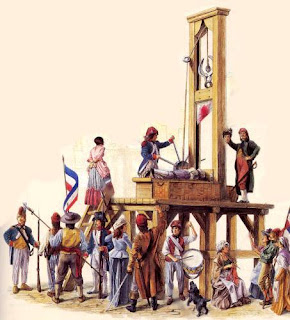18th Century Sugar Cane Plantations
The rise of sugar cane plantations in the 18th Century, particularly on the French islands of Martinique and Saint-Domingue, allowed impoverished French noblemen the opportunity to rebuild their wealth.
Many white plantation owners took African mistresses. Soon, the islands were filled with mulatto children. Some were treated kindly by their fathers and even afforded a superior education; others suffered the pain of not being accepted by either race.
 In the painting to the left, a young mulatto boy holds out a bowl of refined, ground sugar for a French plantation owner to inspect. Meanwhile, the boy's mother, a slave, labors in the background. Though the French passed laws forbidding white plantation owners from engaging in sexual relations with their slaves, the laws were not always enforced. By the mid-18th century, the islands of the West French Indies were heavily populated by the offspring of such unions.
In the painting to the left, a young mulatto boy holds out a bowl of refined, ground sugar for a French plantation owner to inspect. Meanwhile, the boy's mother, a slave, labors in the background. Though the French passed laws forbidding white plantation owners from engaging in sexual relations with their slaves, the laws were not always enforced. By the mid-18th century, the islands of the West French Indies were heavily populated by the offspring of such unions. This golden age of industry revealed a darker, more brutal nature of mankind. Plantation owners bought slaves to work in the fields and process and distill the cane. Slaves were treated worse than horses (in fact, there were laws to protect horses, but not slaves). Most slaves died within their first three years at a sugar plantation. Others were brutalized through beatings, deprivation, and torture.
This golden age of industry revealed a darker, more brutal nature of mankind. Plantation owners bought slaves to work in the fields and process and distill the cane. Slaves were treated worse than horses (in fact, there were laws to protect horses, but not slaves). Most slaves died within their first three years at a sugar plantation. Others were brutalized through beatings, deprivation, and torture. Did you know...
- The famous Napoleonic General, Alex Dumas (father of writer Alexandre Dumas) was born on a plantation in Saint-Domingue, the son of a French nobleman and an African slave?
- The Chevalier Saint-Georges, the finest swordsmen in 18th Century Europe, was the son of a French nobleman and African slave?
- As early as 1664, the French administration passed laws called the Black Codes preventing whites from fraternizing with slaves? A Frenchmen caught having sex with a slave could be lashed and branded.
- 18th Century French sea captains referred to slaves as "bois d'ébène" - ebony wood?
- It was a common practice on sugar plantations for masters to force their slaves to wear tin masks which would prevent them from eating sugar or drinking rum.




What an interesting and tragic post! I took the liberty of sharing it on Elena Maria Vidal's Tea at Trianon Forum.
ReplyDeleteGood post, haunting images
ReplyDelete